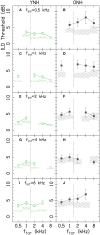Age-Related Changes in Interaural-Level-Difference-Based Across-Frequency Binaural Interference
- PMID: 35966775
- PMCID: PMC9363899
- DOI: 10.3389/fnagi.2022.887401
Age-Related Changes in Interaural-Level-Difference-Based Across-Frequency Binaural Interference
Abstract
Low-frequency interaural time differences and high-frequency interaural level differences (ILDs) are used to localize sounds in the horizontal plane. Older listeners appear to be worse at horizontal-plane sound localization to compared younger listeners, but little is understood about age-related changes to across-frequency binaural processing. This study investigated if the frequency dependence of across-frequency ILD processing is altered for older compared to younger listeners, which was done by using an across-frequency binaural interference task (when the interaural difference sensitivity for a target sound is decreased by a spectrally remote interfering sound with zero interaural differences). It was hypothesized that as listeners experience advancing age and age-related high-frequency hearing loss (i.e., presbycusis), they will demonstrate worse binaural performance and experience more across-channel binaural interference (because of age-related temporal processing deficits), and will increasingly be affected by interferers at lower frequencies (because of age-related hearing loss) when compared to younger listeners. There were 11 older (>65 yrs) and 20 younger (<30 yrs) listeners with normal to near-normal audiometric thresholds up to 2 kHz. They were tested using a left-right ILD lateralization discrimination task. Single-tone ILD discrimination thresholds and across-frequency binaural interference were measured at 0.5, 1, 2, 4, and 8 kHz. ILD thresholds and interference were about twice as large for older compared to younger listeners. Interferers ≤1 kHz produced 2-3 times as much across-frequency binaural interference for older compared to younger listeners. Hearing thresholds were significant predictors of single-tone ILD thresholds; in addition, both target and interferer hearing thresholds were significant predictors of binaural interference. The results suggest a reweighting of binaural information that occurs with advancing age and age-related high-frequency hearing loss. This evidence of plasticity may help explain some of the age-related changes in spatial-hearing abilities.
Keywords: across-frequency binaural interference; aging; binaural hearing; hearing loss; interaural level differences (ILDs).
Copyright © 2022 Goupell.
Conflict of interest statement
The author declares that the research was conducted in the absence of any commercial or financial relationships that could be construed as a potential conflict of interest.
Figures




Similar articles
-
The effect of target and interferer frequency on across-frequency binaural interference of interaural-level-difference sensitivity.J Acoust Soc Am. 2022 Feb;151(2):924. doi: 10.1121/10.0009398. J Acoust Soc Am. 2022. PMID: 35232088 Free PMC article.
-
Effects of reference interaural time and intensity differences on binaural performance in listeners with normal and impaired hearing.Ear Hear. 1995 Aug;16(4):331-53. doi: 10.1097/00003446-199508000-00001. Ear Hear. 1995. PMID: 8549890
-
Binaural cue sensitivity in cochlear implant recipients with acoustic hearing preservation.Hear Res. 2020 May;390:107929. doi: 10.1016/j.heares.2020.107929. Epub 2020 Feb 26. Hear Res. 2020. PMID: 32182551 Free PMC article.
-
How aging impacts the encoding of binaural cues and the perception of auditory space.Hear Res. 2018 Nov;369:79-89. doi: 10.1016/j.heares.2018.05.001. Epub 2018 May 5. Hear Res. 2018. PMID: 29759684 Free PMC article. Review.
-
Spatial Mechanisms for Segregation of Competing Sounds, and a Breakdown in Spatial Hearing.Front Neurosci. 2020 Sep 16;14:571095. doi: 10.3389/fnins.2020.571095. eCollection 2020. Front Neurosci. 2020. PMID: 33041763 Free PMC article. Review.
Cited by
-
Age-related differences in auditory spatial processing revealed by acoustic change complex.Front Hum Neurosci. 2024 Apr 12;18:1342931. doi: 10.3389/fnhum.2024.1342931. eCollection 2024. Front Hum Neurosci. 2024. PMID: 38681742 Free PMC article.
-
The interference of tinnitus on sound localization was related to the type of stimulus.Front Neurosci. 2023 Feb 7;17:1077455. doi: 10.3389/fnins.2023.1077455. eCollection 2023. Front Neurosci. 2023. PMID: 36824213 Free PMC article.
-
A review of auditory processing and cognitive change during normal ageing, and the implications for setting hearing aids for older adults.Front Neurol. 2023 Jun 20;14:1122420. doi: 10.3389/fneur.2023.1122420. eCollection 2023. Front Neurol. 2023. PMID: 37409017 Free PMC article. Review.
-
Exploring the Amplitudes of Binaural Interaction Components Elicited by Diverse Stimuli and Their Relationships With Behavioral Measures in Individuals With Normal Hearing.J Audiol Otol. 2025 Apr;29(2):117-125. doi: 10.7874/jao.2024.00612. Epub 2025 Mar 12. J Audiol Otol. 2025. PMID: 40068841 Free PMC article.
-
Aging does not affect auditory motion discrimination based on interaural level differences.Iperception. 2025 Mar 2;16(2):20416695241311206. doi: 10.1177/20416695241311206. eCollection 2025 Mar-Apr. Iperception. 2025. PMID: 40041547 Free PMC article.
References
Grants and funding
LinkOut - more resources
Full Text Sources

